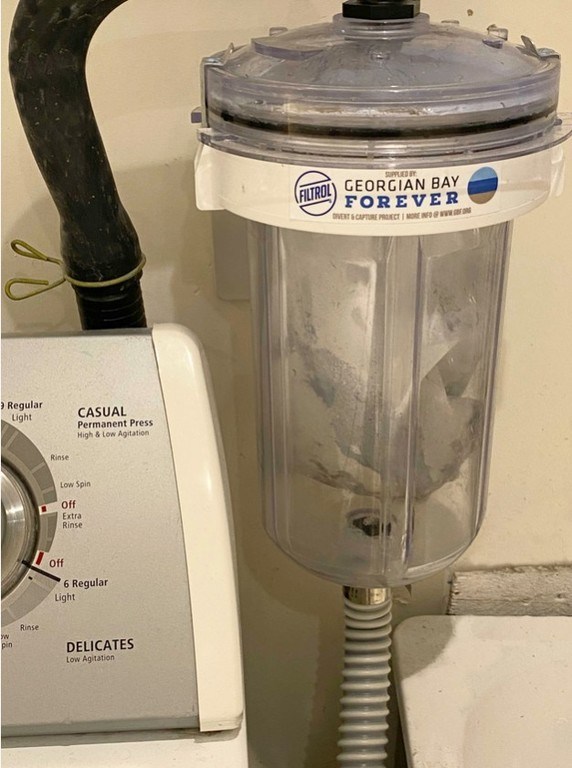
In-Depth
Study reveals washing machine filters can capture harmful microfibres before they enter waterways
November 23, 2021
By
Canadian Manufacturing


A filter affixed to a washing machine. This filter is already starting to accumulate microwaste that is shed from clothing in the wash. The study showed that a filter can capture about 6.4g of lint per week, diverting an estimated 179,000 to 2,707,200 microfibres per week from going down the drain. (CNW Group/Georgian Bay Forever)
PARRY SOUND — A study released on November 18 in Parry Sound reveals washing machine filters as a solution that can capture harmful microfibres before they enter Georgian Bay and other waterways where they can be ingested by wildlife.
The study, a collaboration between Georgian Bay Forever (GBF) and the Rochman Laboratory at the University of Toronto, is the first application of washing machine filters at a community scale. The research measured how filters impact microfibre emissions in water that returns to Georgian Bay via treated wastewater effluent. The results showed that filters installed in about 10% of households, can reduce emissions by at least 10%, or potentially more when combined with education to the greater community.
“We’re excited because this is the first time a lab-proven filter solution has demonstrated positive results in a real-life application,” said Brooke Harrison, Coordinator of the Divert and Capture project, Georgian Bay Forever.
Washing Machines are a significant source of microfibre waste, with one load of laundry shedding up to a million microfibres. Wastewater treatment plants are not designed to catch and dispose of this pollution, leading to billions of microfibres making their way into lakes and oceans, posing a risk for animal health.
The study shows after installing the washing machine filters in 97 households in Parry Sound, they captured 6.4g of lint per week, diverting an estimated 179,000 to 2,707,200 microfibres per week from going down the drain.
“We estimate 934 million to 14.1 billion microfibres were diverted from wastewater treatment plants annually for households in Parry Sound. If we were to scale up to a large city like Toronto (1,179,057 households), then the annual microfibre capture could be more like 12 to 166 trillion,” said David Sweetnam, Executive Director GBF and co-author of the study.
“These results start a conversation with the government and the public about something we can do in our own homes, today, that will drastically affect the pollution impacting wildlife and affecting water quality.”
On April 19, 2021, Ontario Private Member’s Bill 279 was introduced to prohibit the sale of washing machines that are not equipped with a specified microplastics [microfibre] filter. The first reading has carried, and GBF is calling on the public to write their local Ontario Member of Provincial Parliament (MPP) and voice their support for Bill 279.
Print this page
Advertisement
In-Depth
Study reveals washing machine filters can capture harmful microfibres before they enter waterways
November 23, 2021
By
Canadian Manufacturing


Print this page